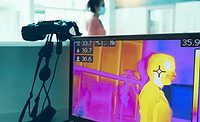Determining the right combination of visible and thermal imaging for perimeter security

Image courtesy of Flir
For surveillance and perimeter protection, capturing useful and actionable video begins with choosing the right surveillance camera technology. Two common options are visible cameras with near infrared illumination capabilities and thermal imaging cameras—both are optimal for distinct situations.
The most common surveillance cameras require visible light to produce images. However, optimal lighting isn’t always available or guaranteed, especially when a scenario calls for 24-hour awareness for security applications, including outdoor, remote, or rural locations, or if there is need to see beyond the fence line to identify and react to incoming threats.
Visible, Near Infrared, and Thermal Sensors
By understanding how cameras rely on the various ranges of light within the electromagnetic spectrum, systems integrators and other security professionals can design a video solution that overcomes most image capture challenges in virtually all types of scenarios.
Electromagnetic energy has different wavelengths ranging from radio waves on the low-frequency end of the spectrum, to gamma rays on the higher-frequency end. The human eye can only see a small sliver of that spectrum—visible light— which ranges from 400-750 nanometers in wavelength and appears as different colors.
Traditional security cameras rely on visible light to create detailed color images, optimal for target identification, facial recognition, object recognition, and evidentiary-class video for court proceedings. These are the standards for video surveillance and satisfy requirements for most use cases. They are also the most affordable and readily available option for most organizations.
Meanwhile, near infrared (NIR) energy is invisible to the naked eye. Visible cameras with NIR illumination can see this light that is invisible to our eyes, which allows them to deliver usable images in low-visible-light scenarios. These cameras utilize NIR lasers or LEDs to beam near IR light, usually 850-940 nanometers, that the imager can see when it bounces off an object and back to the camera. The primary limitation of NIR cameras is that they still rely on reflected light and only produce a grayscale image.
Farther down the electromatic spectrum to the IR mid- and long-wave ranges are thermal imaging security cameras that detect infrared wavelengths up to 14 microns, which humans cannot see but can feel in the form of heat. Unlike active NIR systems, thermal cameras are passive sensors that detect the heat, or thermal radiation, that is emitted and reflected by all objects in the known Universe. By capturing the differences in temperature into high-contrast images, with differences as low as 0.03 degrees Celsius, thermal cameras yield videos that our eyes can easily interpret even if the scene is in total darkness or obscured by light fog, smoke, or dust. Conditions that would typically affect visible cameras—poor lighting, shifting light, poor weather, or reflections—do not have such a pronounced influence on thermal camera visibility. For these reasons, thermal cameras are optimal solutions for harsh, rugged environments that require constant monitoring and long-range detection at and beyond the facility perimeter outdoors.
The Core Factors for Determining the Right Mix of Visible and Thermal Surveillance Cameras
When designing a surveillance system from beyond the perimeter to within a facility, professionals should closely examine the following factors to create the optimal mix that accomplishes the security program goals as efficiently as possible.
Feature Identification: If the application requires identification of specific features on a target such as clothing color or vehicle make, a visible camera is the best option. Outdoor pan-tilt-zoom (PTZ) cameras are often used for this purpose so security operators can follow and identify suspects once a target has been detected, such as by a machine vision camera that can identify objects through artificial intelligence (AI).
Range: To maximize coverage while minimizing the number of cameras installed for cost-savings, camera spacing is critical. Thermal cameras become the optimal choice due to their ability to detect objects potentially hundreds of meters away, even in complete darkness or other challenging conditions.
Environmental Conditions: Sites affected by severe weather that reduces visibility may require a thermal sensor even if the maximum distance to cover is within the range of visible cameras. For example, a visible-light camera situated along a marine environment with a 50-meter range might capture usable imagery at that distance through light fog, but at night in those same foggy conditions the camera’s range is severely diminished. For this reason, thermal can be a more effective option in adverse environmental conditions without sacrificing range.
Video Analytics Performance: If the application requires target identification, like reading the license plate on a car, or identifying a person, a visible spectrum sensor is the only option to consider. Whereas thermal cameras with analytical capabilities can identify shapes, such as a person at night along a fence line, they are not effective at identifying specific individuals. In a scenario where the need is to identify potential threats in any environmental condition, thermal cameras are the right choice as they are also less susceptible to false alarms from sources such as shadows, sun reflections, changing lighting conditions, insects, and swaying foliage.
Weighing Costs Versus Performance with Visible and Thermal Imaging
In summary, visible-light cameras are the best, cost-effective option to satisfy identification and evidentiary standards for surveillance applications. When specifications require a camera that can’t be compromised by inclement weather, has long detection ranges, and performs well with video analytics at night, a thermal camera is the optimal choice.
Taken together, a comprehensive security solution deployed for perimeter surveillance will leverage both thermal and visible cameras with NIR, and better yet, employ radar systems for early warning of potential threats. A turnkey system will also employ multi-spectral, PTZ cameras with both thermal and visible sensors, potentially within the same hardware footprint. These cameras offer valuable color video and in conditions when a visible sensor cannot perform, the thermal sensor provides clear imagery.
This article originally ran in Security, a twice-monthly security-focused eNewsletter for security end users, brought to you by Security Magazine. Subscribe here.
Looking for a reprint of this article?
From high-res PDFs to custom plaques, order your copy today!






